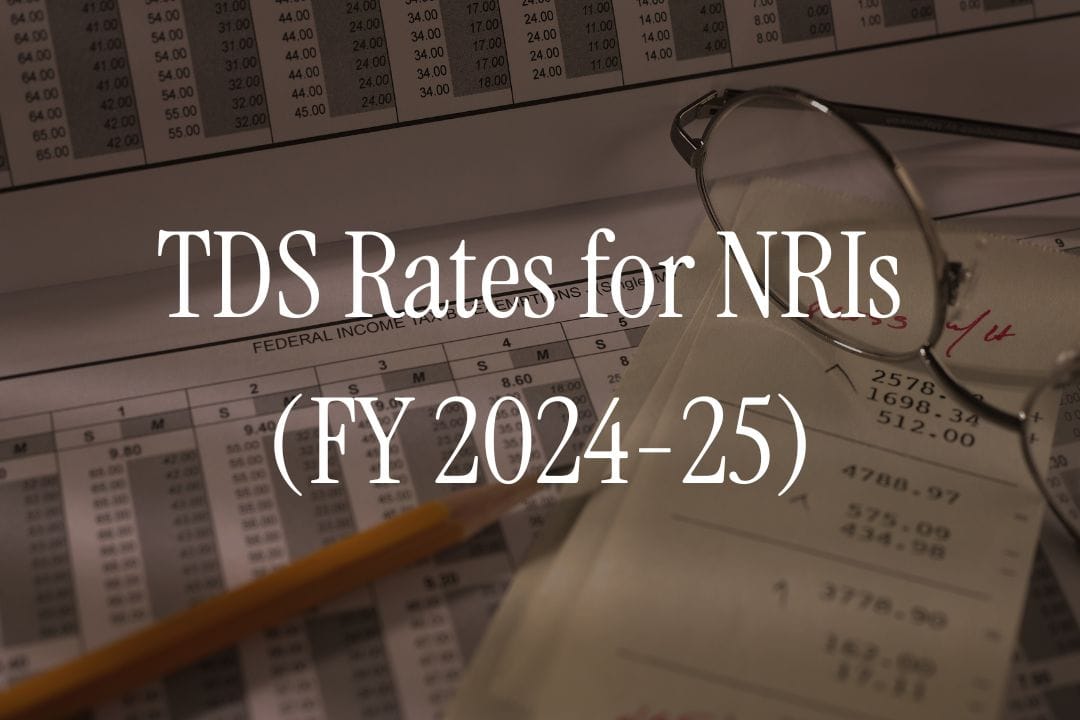Introduction to TDS for NRIs
Tax Deducted at Source (TDS) is a mechanism used by the Indian government to collect tax revenue and ensure tax compliance. This is particularly important in the case of NRIs, who primarily live and work outside India.
By collecting TDS, the government ensures that any potential tax dues on Indian income are accounted for before the money leaves India. TDS is deposited with the government on behalf of an NRI by the entity making the payment to the NRI (e.g. a tenant in the case of rental income from property, or a Mutual Fund House in case of sale of Mutual Fund units). If a refund is applicable, then the individual can submit a claim for a refund by filing their annual Income Tax Return (ITR).
What is Section 195 of the Income Tax Act?
Section 195 of the Income Tax Act delves into the TDS deduction regulations when making any payment to a Non-resident Indian or a foreign company. The TDS is applicable to all payments, excluding salaries and certain interests mentioned in sections 194LB, 194LC, and 194LD of the Income Tax Act.
Who is an NRI under Indian Tax Laws?
According to Section 6 of the Income Tax Act, an NRI is "an individual who is not a resident in India." Your citizenship and passport don't affect this status; your residency status is all about where you physically spend your time.
You can check your residential status for taxation purposes through Belong's NRI residential status calculator
Who Should Deduct TDS?
The payer entity which can be an individual, Hindu undivided family (HUF), other non-resident or resident Indian, partnership firm, individuals with exempted income in India, foreign companies or juristic individuals like a government agency or non-profit organization bear the responsibility of deducting the tax before making the payment to the Non-Resident Indian.
TDS Threshold and When It Applies
Under section 195, there is no threshold limit to deduct TDS. TDS, however, applies only when the payment is taxable in India. Certain NRI incomes like salaries and interests mentioned in sections 194LB, 194LC, and 194LD are not taxable unless specifically mentioned by the government.
TDS Rates for NRIs (FY 2024-25)
TDS as per section 195 is deducted at the higher limit of 30% or based on the time period the asset is held. The rates change during the announcement of the union budget.
The table below shows the different rates of TDS applicable for NRIs according to the latest budget announcement.

| Asset type | TDS on Short-Term Capital Gains | TDS on Long-Term Capital Gains | Who deducts it, on what amount and when |
| Sale of Listed assets – Stocks, Bonds, Equity Mutual Funds, REITs and InvITs | 20% | 12.5% | TDS is deducted by the broker on capital gains at the time of settlement |
| Sale of Non-Equity FOFs/ Gold and Silver ETFs/ Gold Funds/ Overseas FOFs | 20% | 12.5% | TDS deducted by the Mutual Fund House on capital gains at the time of sale of MF units |
| Sale of Debt-Oriented Mutual Funds | 30% | 30% | TDS deducted by the Mutual Fund House on capital gains at the time of sale of MF units |
| Sale of Unlisted stocks/ Foreign Equity/Debt | 30% | 12.5% | TDS is deducted by the buyer on the total sale consideration at the time of payment |
| Sale of Unlisted Bonds | 30% | 30% | TDS is deducted by the buyer on the total sale consideration at the time of payment |
| Sale of Physical Gold | 30% | 12.5% | TDS is deducted by the buyer on the total sale consideration at the time of payment |
| Sale of Physical Real Estate | 30% | 12.5% | TDS is deducted by the buyer on the total sale consideration at the time of payment |
| Rental Income | 30% | 30% | TDS is deducted by the tenant every month when transferring rent |
| Consultant/ Professional Income | 30% | 30% | TDS is deducted by the client whenever payment is made against the invoice raised |
Let's deep dive into TDS on property sale by NRI:
With the changes introduced in the 2024 Union Budget, many NRIs have been paying more in taxes for property sales than their actual tax liabilities. The long-term capital gains (LTCG) tax rate for NRIs has been reduced from 20% to 12.5% (without indexation). The TDS rate on property sales by NRIs has been updated to reflect this change. This means that the default TDS rate on long-term holding of property (>24 months) deducted on the sale of property by NRIs remains at 12.5%.
On top of this, surcharges and cess apply depending on your total income:
Total income is below ₹50 lakh - No surcharge, thus effective TDS: 20.80%
Income is between ₹50 lakh and ₹1 crore - 10% surcharge on 20% LTCG tax, thus effective TDS: 22.88%
Income is more than ₹1 crore - 15% surcharge on 20% LTCG tax, thus effective TDS: 23.92%
These rates apply unless you obtain a Lower Deduction Certificate (LDC) from the Income Tax Department. The application process for the LDC has been discussed below.
| Scenario | Tax Payable | TDS Deducted |
| Without LDC | 12.5% (actual LTCG tax) | 20% + surcharge + 4% cess (TDS) |
| With LDC | 12.5% (or lower if applicable) | Only the approved rate (typically 12.5% + surcharge) |
How to Claim Refund on TDS Deducted
To claim a refund on TDS deducted, NRIs need to file an Income Tax Return (ITR) in India for the relevant financial year. After verifying the TDS details in Form 26AS, they should calculate their actual tax liability. If the TDS paid exceeds this liability, the excess amount can be claimed as a refund while filing ITR (usually ITR-2 or ITR-3). The refund is processed by the Income Tax Department and credited to the NRI’s bank account linked to their PAN.
A relief mechanism that helps residents and NRIs to lower TDS burden using a Lower TDS Certificate, also known as Form 13. It is a certificate issued by the Income Tax Department, allowing the deductor to deduct lower tax at the source than the standard rate. It is particularly helpful for NRIs who are liable to pay taxes both in India and abroad. The certificate is valid only for the financial year for which it is issued and should be renewed each year.
How to Apply for Form 13:
Visit the TRACES portal
Sign up as a taxpayer
Under the ‘Statements / Form’ tab, select ‘Request for Form 13’
Form 13 would be displayed, and the appropriate details need to be filled up by the applicant
Upload supporting documents, which include a Tax Residency Certificate, proof of tax payments, income statements, investments, and any other relevant financial documents
Once submitted, the online Form 13 is processed and reviewed by the Assessing Officer (AO)
The AO asks for clarification and further documents, if any
Post AO approval, the application is forwarded to the Additional Commissioner of Income Tax and then to the Commissioner of Income Tax for approval
The application is then successfully completed, and the process for the generation of lower withholding certificates is initiated
Once the Lower Withholding certificate is generated, the same can be downloaded from the TRACES portal.
NRIs can also reduce their tax liability by claiming the DTAA provisions of their country of residence.
If you are a UAE based NRI, to know more about the India-UAE DTAA agreement you can read this blog and understand how DTAA can reduce the tax liability of UAE based NRIs.
Penalties for Non-Compliance of TDS
The penalties for non-compliance with TDS are charged on the payer, not the NRI liable for payment of the taxes.
If TDS is not withheld or deposited in time, the payment is disallowed as a deductible expense for the payer in the year of payment
If TDS is deducted but not deposited by the due date, interest at 1.5% per month is charged from the date of deduction until the date of actual deposit
If TDS is deducted but not deposited at all, a penalty equal to the TDS amount may be levied under Section 221
If TDS is partially deducted or deposited, a penalty equal to the difference between the deductible and actually deducted amount may be imposed under Section 271C.
The penalties for non-compliance with TDS are charged on the payer not the NRI liable for payment of the taxes.
When to Consult a CA?
While it is complex to navigate taxation independently, there are many things that require and many that don’t require a CA. For instance, if you are selling a property in India, a CA can help calculate the exact capital gains, determine actual tax liability, and guide you through the application process for a Lower Deduction Certificate (LDC) to avoid over-dedication of TDS. Similarly, when repatriating funds abroad, banks require Form 15CA and 15CB as proof that taxes have been duly paid. A CA can help prepare and certify these forms.
If an individual is well acquainted with the filing, calculation and application processes, there is no need for a CA; however, it is worth considering the time that can be saved by outsourcing these tasks to professionals who also minimise the error possibilities. Overall, involving a tax expert early in the process can prevent penalties and costly mistakes and ensure a smoother tax-filing process.
Key Takeaways for NRIs on TDS Deduction and Section 195
Although the taxation landscape may seem like a maze of regulations and paperwork, section 195 of the Income Tax Act serves as a crucial guidepost. It enumerates the procedures involved, criteria and other essential information to ensure your compliance. Though the process may seem overwhelming at first, with a little bit of research or support from a qualified CA, this web becomes much easier to navigate. Understanding your obligations under this section not only helps avoid penalties but also helps you save.





